Ecopiles - Seeing the trees not the wood
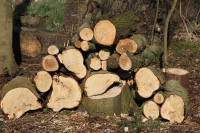
We, as sportsturf managers, are probably all aware, by now, that the majority of the UK's invertebrates are in decline. A number of greenkeepers I've talked to have mentioned that they are paid to manage a golf course and not a nature reserve, but I believe that, by making the tiniest of changes to the way we work, it would result in one huge difference to the environment and the way that we are often perceived by the public - a waste of land and water springs to mind for that one!
Unfortunately, this section of the public have already made up their minds that golf courses are environmentally poor where nothing good comes from them. Not unlike that small group of members at most courses have who have made up their minds that your golf course is managed badly, and that is that!
So, with this in mind, the aim of this article is to introduce you to a minor project. One that can result in a significant change to the amount of wildlife you have on your golf course.
How do you make an eco-pile?
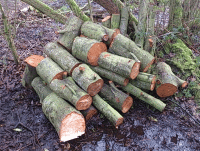
What do you then do with the wood? Simply cut it into manageable sizes and then stack it neatly in an out-of-play area; behind a tee or even deep in the woodland will do. Ideally though, it should be seen by golfers and visitors to your facility where it will then raise the question "why do you stack the wood like that?", which is where you come in with the answers that are provided in this article.
Before I proceed any further, however, there's still the question of what to do with the rest of the branches that are associated with a fallen tree. Chipping on site is a possibility. The woodchip can be recycled, along with your grass clippings and leaf material to make compost.
Burning, as previously mentioned, is an option, but your burning site may be many metres away from the fallen tree, so this then requires a tractor, trailer and countless man hours. Stacking as a hibernacula for hedgehogs is also an option, but you then have to take into account that there is now a fire risk during the summer months when the stacked twigs and branches start to dry out - careful thought is required for that one!
So, back to the eco-piles. There really is no set way of stacking them, other than making them as stable and neat as possible. I have added two photographs of examples of the type of eco-piles we have here at Fairhaven. In the main image (left), wood has simply been stacked carefully so as to appear neat and tidy. The image below shows vertical timber. Why stack timber vertically I hear you ask? Female stag beetles lay their eggs in the openings of vertical decaying timber and, as we all know, stag beetles are in trouble with a lack of places to live.
Also, vertically stacked timber acts as a brace for the taller horizontal piles, so everyone's a winner! The fact that stag beetles are almost non-existent north of Dudley doesn't concern me at this point, because we are having this global warming affair drummed into us on a daily basis, and I guess it won't be long before we start seeing them 'up north'.
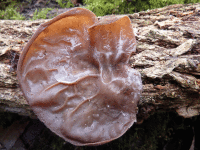
The list really is endless, you know. Numerous types of ground nesting birds (vertebrates) have been recorded raising their families in an eco-pile, including robin, wren and blackbird. The decomposing gaps are home to some of the UK's larger rare invertebrates, such as the ant beetle, and may become an overwintering site for bees. Plants, lichens, micro-organisms and fungi, including the amusingly shaped Judas's Ear (Auricularia auricula-judae) cohabit eco-piles too!
It is, of course, best to leave a decaying tree standing for woodpeckers, treecreepers and nuthatches to forage in, but it is not always safe to do this on a golf course or near property, so survey the tree carefully before deciding to leave it standing.
Saproxylic invertebrates, for example hoverflies, need eco-piles too! Saproxylic invertebrates are those that depend on decaying wood at some point in their existence. Studies as recent as the turn of this last century discovered that most, if not all, saproxylic species are in decline due to the amount of both live and, subsequent, dead timber taken from the woodland floor. Indeed, the most important habitats for saproxylic invertebrates are tree cracks, leakage of tree sap, decaying sap and decaying sap underneath decaying bark - all of which can be found mainly in tree stumps and dead fallen trees.
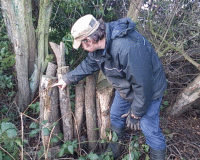
Hoverfly larvae tend to feed on this aforementioned bacteria. However, they also have a liking for smaller insect larvae in this zone too, so it really is survival of the fittest down there!
A typical characteristic of this particular microhabitat is that it is usually quite lively and that it will not last that long. Hence, for strong survival rates of saproxylic invertebrates, a continuous supply of eco-piles is required; something us sportsground managers can assist with quite admirably I feel!
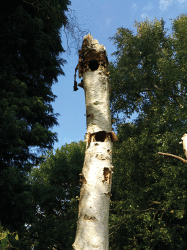
Legal liability for unsafe trees has become stricter, but often there are options for meeting the requirements of both public safety and conservation. For instance, this silver birch tree (right) has succumbed to the brown birch bracket fungus and, as a consequence, has become unstable. The tree is in an out-of-play area in the woodland where very few people go, so why cut it down?
As the picture shows, there are numerous holes made by Great Spotted Woodpeckers to raise their young - the holes will often be used again by winter roosting birds, including starlings, which are now on the RSPB's Red List of our declining feathered friends. Bats may take an interest too - both Noctule (Nyctalus noctula) and Serotine (Eptesicus serotinus) have been observed roosting in abandoned woodpecker holes. However, if you are lucky enough to have either of these bats in your woodland then it will become nigh on impossible to remove the tree, as both these bats are protected by law.
Alternatively, if the tree did not have any bats and had to be cut down because of health and safety concerns, then why not stack it as an eco-pile as close to its original location as possible. The woodpecker's holes would then be used by members of the mouse family or maybe, as mentioned earlier, small birds, including wren and willow tit.
Conclusion

As with all wildlife, whether it's on a golf course, sportsground or within intensely managed woodlands, there is the need to keep the equilibrium balanced correctly. What I mean is that, if you remove all the decaying timber from the floor, then you remove a significant amount of food from the web, including the soil food web. On the other hand, if you create too much, then you run the risk of introducing too much of a certain type of wildlife which, therefore, becomes unsustainable. The trick is to create a habitat where sport and wildlife can live together in congruence. Eco-piles are just one way in which we can achieve this, so what do you have to lose?
This article is brief and in no way exhaustive, but I just wanted to introduce you to eco-piles and how they are an option for your fallen timber on your sportsground.

For further information on James' consultancy and a snippet of his work please contact him via email: jameshutchinson38@googlemail.com or 07590 512749.



